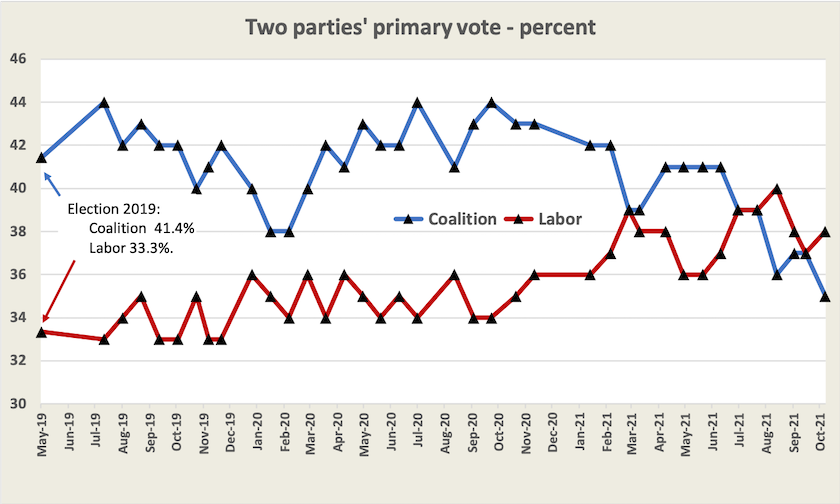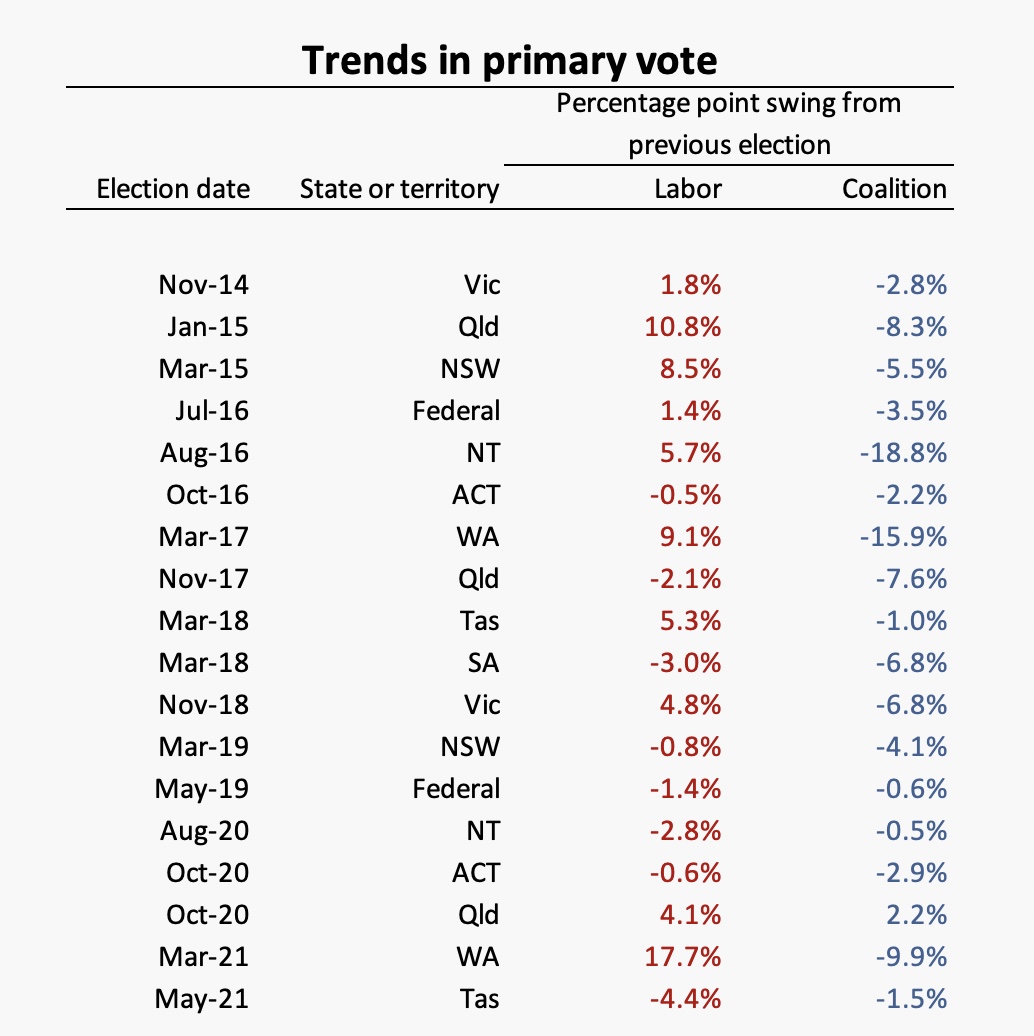Polls and surveys
Labor’s fortunes are still improving
The media have given significant attention to the report in Monday’s Newspoll showing a 54:46 two-party lead for Labor. Not too much should be read into two-party leads, however, because they involve too many assumptions about preference distributions and each assumption bears a sampling error. But the trend in primary vote over the last twelve months, shown in the graph below, would be of concern to the Coalition.

Even if we disregard the extreme points on this graph, we can say that the Coalition’s primary support over the last twelve months has fallen from around 43 percent to around 36 percent – 7 percentage points – while Labor’s has risen from around 34 percent to around 38 percent – 4 percentage points. William Bowe provides further detail on the Newspoll in relation to climate change: our concern about climate change is rising while our concern about the price of electricity (the Coalition’s traditional issue in its climate-change scare campaigns) is diminishing.
Bowe on a separate post reports on a Resolve Strategic poll, which looks a little better for the Coalition. It shows the Coalition on 37 per cent (within the Newspoll margin of error) and Labor on 34 per cent (significantly lower than the Newspoll estimate). Adrian Beaumont, writing in The Conversation, provides some more analysis of the Newspoll and other polls about particular seats. He expects the Coalition’s fortunes to improve as the big states get on top of Coronavirus, but he isn’t finding evidence of such a move so far.
Where are the other votes going?
What both Newspoll and Resolve Strategic reveal is low combined Coalition-plus-Labor support – Newspoll 73 percent, Resolve Strategic 71 percent. Because opinion polls tend to be biased against very small parties and independents, these are probably overstatements of support for major parties. In spite of this bias these estimates are lower than their 75 percent combined vote at the 2019 election.
Who is in this space being vacated by the major parties? The Greens seem to be stuck on about 10 percent, and One Nation on about 2-3 percent. That still leaves plenty of room for strong centrist independents, or movements on the far right. Bowe reports on another poll by Redbridge showing UAP surge (19 percent) in western Sydney (Banks, Lindsay and Macquarie). It’s a strange selection, because while Lindsay and Macquarie are on Sydney’s western fringe, Banks is relatively central: there is no clear reason for this particular selection.
Longer term – is the Coalition in terminal decline?
If we consider longer-term trends, the Coalition’s fortunes are waning. I have pulled together the percentage point swings in primary votes for state, territory and federal elections over the last seven years.

In all but one of those 18 elections the Coalition vote has slipped. The exception was their 2.2 percent gain in the 2020 Queensland election, explained largely by a 6.6 percent collapse in the One Nation vote and a return of those voters to the LNP. Some may note the Coalition’s poor showing in 2018 in South Australia, even though they took power from Labor. This was partly about correcting previously unfair electoral boundaries, and the rise in support for SA Best.
This is not to say the electorate is moving to Labor. The Coalition can still win elections with help from groups further on the right, as it did in 2019 when it was pulled over the line by Clive Palmer’s UAP. And if it were not so intransigent on climate change and treatment of refugees it may gain support from centrist independents. But there is a trend away from the Coalition, matched only partially by a gain in support for Labor. Applying population weightings to these results, doing some back-of the-envelope calculations, and not worrying about state-federal differences, I calculate an annual trend of 2.6 percent away from the Coalition and a 1.7 percent gain for Labor. Some even more crude calculations of elections in New South Wales and Victoria, where the National and Liberal Parties run separately, show the Nationals to be faring even worse than the Liberals, because when they lose a percentage point or two it’s off an already low base.
What lies behind the rot – factionalism
Such calculations, with far more forensic detail, would be keeping Liberal Party analysts employed (and possibly National Party analysts). There will be numerous explanations and accusations, and when a political movement is on the slide there is there is rarely one cause. Writing in Inside Story Rob Manwaring of Flinders University looks at the tensions in the South Australian Liberal Party – Heading South – where factionalism is tearing the party apart. The Marshall Government, dominated by liberals, has performed well, but “the conservatives, flailing in the face of this shift to moderate liberalism, have turned to recruiting members from the state’s Pentecostal churches to shore up factional support”. Manwaring’s analysis is not only about the South Australian party: it’s also about the federal party (where the conservatives are firmly in control) and the worldwide fraying of the accommodation of liberal and conservative traditions that have held centre-right parties together.
Essential on governments, net zero and employment
The Essential Report this fortnight has the usual questions on how we think governments are handling the pandemic. There’s not much change from previous surveys; state governments enjoy higher approval in those states yet to experience the spread of Covid-19. Respondents believe that state governments are doing better than the federal government: Victorians are particularly unimpressed by the federal government’s performance.
This time Essential also asks what people think of their premiers in a general sense, rather than specifically in relation to Covid-19. But people are thinking of Covid-19: those who have kept Covid-19 out score very well. (How does Western Australia’s Mark McGowan consistently score an approval rating of round 80 percent?). It is notable that just over a month ago New South Wales’s Gladys Berejiklian enjoyed 75 percent approval among voters in her state. Dominic Perrottet’s approval is at 47 percent, but there is another 25 percent who “don’t know” about Perrottet.
On net zero, Essential confines its questions to what policy approach to climate change (more or less ambitious targets for 2030 and 2050) would be the best for jobs. Unsurprisingly, in relation to 2030 targets, there are significant partisan differences: in response to the statement “Set a more ambitious target for 2030” there is 55 percent agreement among Greens supporters, 43 percent agreement among Labor supporters, and only 27 percent agreement among Coalition supporters. There is still a sizeable minority (16 percent), mainly Coalition and “other” supporters, who believe there should be no targets for 2030 or 2050.
On the federal government’s labour policies there is a statement “The federal government’s role is to reduce taxes and red tape so businesses can employ more workers”. That view doesn’t have huge support: 44 percent of Coalition supporters agree and 30 percent of Labor supporters agree. There is also gender difference: 42 percent of men agree while only 29 percent of women agree. No marks for guessing who’s got the better-paying jobs.
And there is a statement “with government support, Australia can have a successful manufacturing industry”. Most of us agree, but in itself that doesn’t reveal much. The big question in Australia over the last 120 years has been about how governments should support industry but Essential does not pose that question.
Essential also has a set of questions on immigration: see the entry on immigration in this week’s roundup.